
The IceCube Neutrino Observatory has a uniquely close relationship with ice. The telescope needs ice—and a lot of it—to detect the astrophysical neutrinos it was built to study. In fact, most of IceCube’s instruments are embedded in a cubic kilometer of ice at the South Pole. Construction of the detector required drilling 2.5 kilometers straight down into the Antarctic glacier and lowering cables of sensors into each hole. The bottom line is that you can’t have IceCube without ice.
And while IceCube may be known for its breakthroughs in neutrino astronomy, there is a dedicated group of researchers within the collaboration that focuses on the Antarctic ice and glaciology. These IceCube collaborators study things like the properties of light propagation in the ice and ice stability at the bottom of the Antarctic glacier.
“Understanding the ice better is essential to improving our science,” said Delia Tosi, assistant scientist at the Wisconsin IceCube Particle Astrophysics Center and IceCube collaborator. “Many of the properties we rely on for neutrino detections (such as light scattering and absorption) are tied to a microscopic description of the ice, which only the glaciology community can help us untangle.”
Yesterday, the Second IceCube Polar Science Workshop wrapped up after two days of talks and discussion. With 135 registered participants and 25 talks, the interdisciplinary workshop brought together scientists and engineers from around the world to discuss the interplay between glaciology and neutrino astronomy.
Topics for talks included drilling technologies and logistics, bedrock morphology and characteristics, englacial heterogeneities and structures, optical and radio ice birefringence, and microscopic analysis of ice core samples.
“The goal of the workshop was to strengthen the flow of ideas and recent results between the glaciology and neutrino astronomy communities,” said Martin Rongen, a postdoc at Johannes Gutenberg University of Mainz and an organizer of the workshop, along with Tosi and others. “We want to see how we can profit scientifically from each other.”
While IceCube collaborators already use glaciology concepts in their research, there aren’t many neutrino astronomy concepts or results that are directly useful to glaciology (yet). Rongen believes that they are getting close to a point where IceCube’s ice model may be informative to the field of glaciology. Plus, with a couple of upcoming extensions to the IceCube detector (the IceCube Upgrade and IceCube–Gen2), there are opportunities to deploy specific instruments that measure the ice properties that glaciologists are interested in.
IceCube’s history is embedded in ice (literally and figuratively), so maintaining and strengthening the relationship between neutrino astronomy and glaciology is and will continue to be important for the IceCube Collaboration.